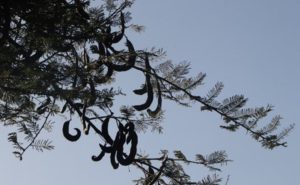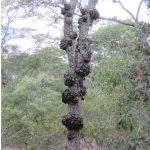TREE LIFE
JUNE 2023
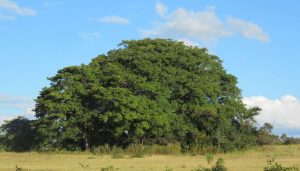
Copse of trees viewed during our recent Tree Society visit to the Mafungautsi Plateau near Gokwe
Hi Everyone,
Apologies for getting this Newsletter out late but it has just been one of those months.
Above you see an intriguing copse of trees that we viewed from a distance during our recent Tree Society visit to the Mafungautsi Plateau around Gokwe. We had no time to investigate this, but ideally we should go back and see exactly what trees do make up these strange isolated patches of woodland. Maybe they started on a large termite mound, or perhaps they were left after a fierce fire destroyed surrounding woodland. Who knows?
There is so much of Zimbabwe that needs detailed investigation to make sure we know which trees occur where and whether they are threatened by changing land use, climate or other factors. No doubt after this warm winter there will be terrible fires!
POINTS OF INTEREST FROM THE GOKWE AND MAFUNGAUTSI VISIT: 15 TO 18 APRIL 2023 by Mark Hyde
Introduction
Tony asked me to highlight any features of the Tree Society visit to the Gokwe / Mafungautsi Plateau and Forest Reserve that I thought were of interest.
General comments
The first time I visited Gokwe many years ago I was staggered to find that the town is on Kalahari Sand; street tree species are typical Kalahari Sand species such as Baikiaea plurijuga (Zambezi teak) and Schinziophyton rautanenii (Manketti tree), reminding me so much of the Victoria Falls. There was the same experience on this visit but as we headed for our accommodation, the Pumba Safari Lodge, we turned right off the main road and descended from the Plateau into miombo woodland with no Kalahari Sand species.
Although the main target of interest for our visit was the Kalahari Sand area of the actual Forest Reserve, quite a number of places where we botanised, specifically, our Lodge, the waterfall (the Mbumbusi Falls) and the area near Sengwa Dam number 2 were not on Kalahari Sand and were miombo woodland. In fact, it was quite easy as we drove around to tell from the tree species whether we were on the Kalahari Sand or not.
Within the Forest Reserve itself, the woodland was quite open. I was surprised by how little ground cover there was; miombo woodland at this time of year would show many species, typically legumes, and very few plants at all were seen here. Perhaps this is because of the lower rainfall of the area; although per Mudekwe, J, (2007) this is 680 mm per annum which is not particularly low. The altitude of the Reserve was also quite high at about 1250 m, only 250 m below Harare.
Another common habitat was the many vleis snaking through the Reserve and it seemed that the roads often took us along the interface between the Kalahari Sand woodland and the vlei edges. Most of the vleis were quite spacious, tree-less and mainly pretty dry. Some vlei species are discussed later in this article.
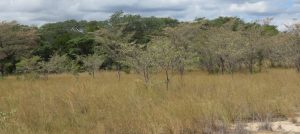
The interface between the Kalahari Sand woodland and the vlei edges
Species on the Kalahari Sand
Living in Harare where we are distant from any Kalahari Sand, we don’t often see the typical Kalahari Sand species, apart from a few cultivated in the Botanic garden. and it was a pleasure to re-acquaint ourselves with Baphia massaiensis (Sand camwood), Baikiaea, Bauhinia macrantha (Kalahari bauhinia), Combretum collinum subsp. ondongense (Kalahari bushwillow), Erythrophleum africanum (Ordeal tree) and Schinziophyton.
Other more familiar species of the Kalahari Sand were Burkea africana, Bobgunnia madagascariensis (Snake bean), Euphorbia matabelensis, Ochna pulchra, Pterocarpus angolensis (Mukwa), Securidaca longepedunculata, Strychnos cocculoides… and, quite frequently, msasa, Brachystegia spiciformis.
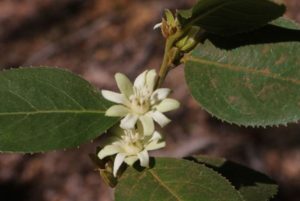
An exciting find was Paropsia brazzeana, (the weirdly named Kalahari green-bubble) very much a typical Kalahari Sand species, here for the first time for me it was in creamy-white flower. It is a very attractive shrub with alternate, toothed leaves. Its family is unusual, the Passifloraceae (Passion-flower family) containing species such as the Granadilla which are more usually herbs or climbers. Flowers of the family possesses a third row of structures in addition to the calyx and petals, known as the corona.
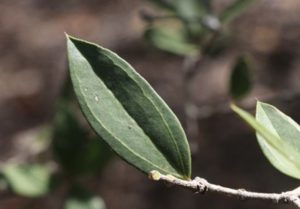
Another nice find was Strychnos pungens (Spinyleaved monkey-orange). The leaves are narrow and the three veins from the base which are typical of Strychnos leaves are particularly prominent. The specific name ‘pungens’ does not in this case refer to anything smelling strongly on the plant; it is an alternative meaning of pungent, meaning sharply pointed and, indeed, the leaf apex does have an unusually long apical point.
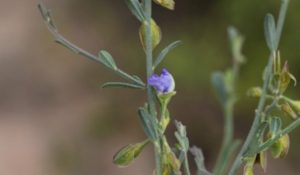
Polygala kalaxariensis – this very pretty blue-flowered perennial herb was first spotted by Cathy Sharp who brought me a specimen. One feature is that the stalks bearing the mature fruits reflex as the fruit matures. This species was new to me and seems to have been rarely collected in Zimbabwe. Oddly, it is not confined to Kalahari sand as it also occurs in the sandy suburbs of southern Harare, as demonstrated by old herbarium collections, although I personally have never seen it.
Another species of interest was Vitex mombassae (Smelly-berry fingerleaf). Both Meg and I have very rarely seen this species in the field. Although each leaf has 5 leaflets, typically a high proportion of the leaves has only three and this was the case here.
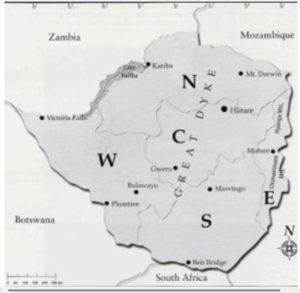
Flora Zambesiaca divisions
As an aside, in case people are not familiar with them, the Flora Zambesiaca project divided Zimbabwe into 5 divisions, labelled N, W, C, E and S, roughly corresponding to compass points. The di-visions are shown on the map.
The flora of Zimbabwe is quite well-known, and it is not easy to find species which are new to a particular division.
Gokwe lies in the northern division and on this trip, we found two species new to that division.
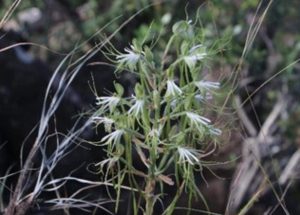
Bonatea steudneri
The first was the flowering orchid with the large inflorescence which was growing at the waterfall site. This was identified via Rob Jarvis as Bonatea steudneri.
The other interesting novelty was a small suffrutex Rubiaceae. There were no flowers or fruits but the leaves which were borne in both pairs and whorls of three and which also were a good match with specimens at the Herbarium strongly suggest that this was Vangueria ferruginea. It was formerly known as Ancylanthos rubiginosus, which is the name we are still using on our website: https://www.zimbabweflora.co.zw/speciesdata/ species.php?species_id=156170. It is an unusual Vangueria of the Kalahari Sand with orange-yellow flowers.
The waterfall (Mbumbusi Falls)
As Rob Jarvis has already remarked, we anticipated a waterfall, but there was none. There was a small rocky valley which fell steeply into a much deeper valley, but no water was present. Surrounding the “falls” was some rocky miombo woodland (not on Kalahari Sand) which we explored. There was a fair number of species seen, although nothing was particularly unusual, apart from the aforementioned orchid.
One plant which puzzled us at the time was a tall bushy pavetta. This turned out to be the familiar Pavetta schumanniana and an odd-looking Psydrax livida turned out to be just that. There were also plants of Bauhinia petersiana, as distinct from the Kalahari sand species, Bauhinia macrantha which we saw elsewhere.
The bottom of the valley contained a fine colony of Senna didymobotrya (Peanut butter cassia). This species is indigenous to Tropical Africa, a fact I had forgotten at the time. This dense colonisation of a favourable habitat suggests an alien species but it seems not in this case. We came across large colonies of it again in another stream bed on the Monday.
Vlei species
One was the Dwarf custard-apple, Annona stenophylla subsp. nana which formed patches of approximately knee-high stems and puzzled us a lot at first. There was also plenty of the patch-forming Parinari capensis.
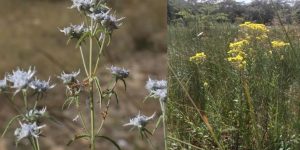 There were also the pretty blue flowers of Haumaniastrum sericeum. In the one wet vlei there was a striking yellow plant of Helichrysum cooperi in full flower.
There were also the pretty blue flowers of Haumaniastrum sericeum. In the one wet vlei there was a striking yellow plant of Helichrysum cooperi in full flower.
The great Vachellia (Acacia) luederitzii controversy
On the Saturday, the day of our arrival, a large group went off to the Sengwa Dam no. 2 to botanise; I stayed with another smaller group who listed trees around the lodge. The travelling group returned with a most unusual-looking specimen of a Vachellia. This had thick pods, resembling those of Vachellia sieberiana, but these were in many cases strongly curved. Furthermore, there was great variation in the spines, some long, some short and some curved and prickle-like. The picture shows some of the curled pods.
The same entity was seen the next day on Kalahari Sand on a walk we did from the Forestry Commission HQ.
The immediate question was – was it Vachellia luederitzii? This is a Kalahari Sand species, quite rare in Zimbabwe which has the same variation in spine shape as our tree. Quite a fierce debate took place at the time and subsequently over the specimens in the Herbarium. In the end it was decided that the plants were Vachellia sieberiana var. woodii, which is of course a very common species and not a very exciting conclusion.
To reach that decision one has to accept the variability of the spines of Vachellia sieberiana.
Also sieberiana pods are not normally strongly curved; in fact, we found no specimens in the Herbarium with strongly curved pods at all. It was speculated that the Gokwe pods had been attacked by a gall which had produced the unusual shape.
As a postscript to this discussion, on 27 May 2023, I visited the Mukuvisi Woodland for Meg’s talk and I noticed that a Vachellia sieberiana in the carpark had very similar curved pods. I think this supports the conclusion that the Gokwe plants were sieberiana. It also appears that curved pods are commoner than we thought.
Unnamed specimens
Meg Coates Palgrave and I made a collection of any plants which we could not identify at the time and, in two sessions at the National Herbarium, we managed to identify all but a few of the collections. A spreadsheet of all the records has been compiled and circulated to those who attended.
Five specimens require further work. The shrubby Grewia we saw on the walk from the Forestry HQ and which we named at the time as Grewia decemovulata is definitely not that and despite a lot of effort remains unnamed. Perhaps it is a strange form of Grewia bicolor? There is an unknown Searsia and also 3 herbaceous plants which will require careful keying out.
Reference
Mudekwe, J. (2007) Management Practices. Teak forests of Western Zimbabwe.
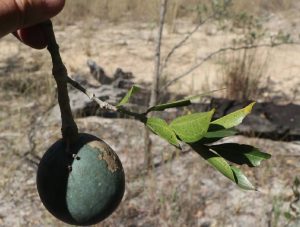
Photo left shows the bluish-green fruit of Strychnos pungens
Below is a picture of Brachystegia woodland on the summit of Buchwa Mountain looking south.
Photo: Rob Jarvis
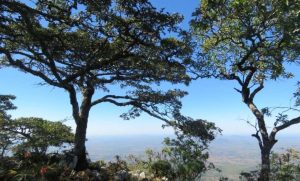
National Botanical Garden Tree Walk 5th May 2023
By Tony Alegria
Only seven guys turned up for this tree outing, presumably all the girls stayed at home to watch the Coronation! Present were: Gus Le Breton; Jan van Bel; Jim Dryburgh; Mark Hyde; Ryan Trusscott; Tony Alegria and a nonmember Michael Laban.
We began the day by looking at all the bits of a twice-pinnate leaf. By breaking off different bits off it, we could see what a once pinnate leaf looked like and also a simple leaf. The first twice-pinnate leaf we looked at was from the Leucaena leucocephala which is a small fast-growing tree native to southern Mexico and northern Central America. Common names include white leadtree, river tamarind and tan-tan.
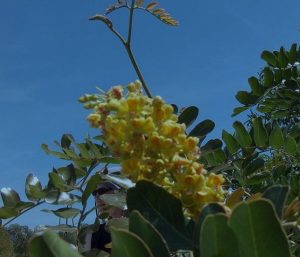
Tara spinosa flowers Photo from Wikipedia
On route, we just had to have a look at the birds egg fig, Ficus ottoniifolia subsp. macrosyce, which between the three trees appears to have a fig or two all year round. Next up was a tree from Peru – the Tara spinosa. Peruvian carob or spiny holdback which looks very much like an Albizia but has thorns on the rachis and sometimes on the pinnae. But unlike the shaving brush flowers of the Albizias, it has rather attractive yellow/orange flowers and a small pod which is raised above the seeds with a pinkish colouration depending on how much sunlight it receives. Then we looked at the Erythrophleum suaveolens. Forest ordeal-tree with rather large leaves.
We then had a diversion to look at another fig tree, the Ficus usambarensis from Tanzania which has many common names including Kitakata and Kawambwa fig. This tree is about twice as wide as high and has thick growing tips, the attractive figs are small and warty but the interesting thing about this tree is just how loud the green leaves crackle when folded!
We then went off to see the other ordeal tree, Erythrophleum africana which unlike the trees we saw on the Gokwe trip, the leaflets were soft to the touch. Nearby was a Hexalobus monopetalus. Shakama-plum with some ripe fruit which we sampled. We were amazed at how red the edible flesh was! It was another of the bush fruits that you had to be really hungry to enjoy – at least they were not unpleasant!
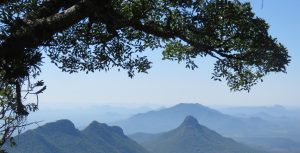 The last twice pinnate leaved tree we had a look at was the Amblygoncarpus andongensis. Scotsmans-rattle which had no fruit and the leaves were too high up beyond our reach. I’m told that elephants relish the fruit so don’t camp under them!
The last twice pinnate leaved tree we had a look at was the Amblygoncarpus andongensis. Scotsmans-rattle which had no fruit and the leaves were too high up beyond our reach. I’m told that elephants relish the fruit so don’t camp under them!
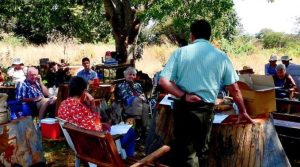 CHAIRMAN’S REPORT 2023
CHAIRMAN’S REPORT 2023
Welcome to the 73rd Annual General Meeting of the Tree Society of Zimbabwe. I have pleasure in presenting my eighth annual Chairman’s report covering the year 1st April 2022 to 31st March 2023.
Tree Outings: Besides meeting at the National Botanical Garden every month, we had quite a busy year with outings to: Dandaro; Greystone Nature Preserve; St. Georges College; Mbiti Lodge at Dawendale Dam; Pleasantways; Lake Chivero Arboretum; Pauline & Brian Ballinger’s property; Patrick Mavros; Dandaro roadside; Margy Tredgold and Christon Bank. Many thanks to the residents of these properties for hosting us.
Tree Leaders: We are still short of leaders and we would really like a few more. You don’t have to know everything as whoever is participating can “chip in” and make the outings even more special!
Weekend Trips: We didn’t have any weekend trips in the last year, but we have just had one to Gokwe. Thanks ever so much to Frances Morris for organizing it. Resulting reports will appear in Tree Life.
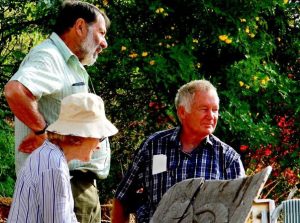 Tree Life: Rob Jarvis remains as the editor of Tree Life. At the last AGM, I appealed for more members to come forward and learn to become editors so we can have more depth in the Society – it appears that my appeal fell on deaf ears. All of you can do it, so let’s have some volunteers. Thanks to those who contributed write-ups on our outings for Tree Life – in order of appearance: Rob Jarvis / Mafungi; Linda Hyde; Tony Alegria; Jan van Bel; Ann Sinclair; Ryan Truscott; Mark Hyde and Frances Morris. Apologies to anyone I may have left out. This must be the least number of contributors we have had in many years!
Tree Life: Rob Jarvis remains as the editor of Tree Life. At the last AGM, I appealed for more members to come forward and learn to become editors so we can have more depth in the Society – it appears that my appeal fell on deaf ears. All of you can do it, so let’s have some volunteers. Thanks to those who contributed write-ups on our outings for Tree Life – in order of appearance: Rob Jarvis / Mafungi; Linda Hyde; Tony Alegria; Jan van Bel; Ann Sinclair; Ryan Truscott; Mark Hyde and Frances Morris. Apologies to anyone I may have left out. This must be the least number of contributors we have had in many years!
Tree of the Month: Ryan Truscott has written many articles on this topic for Tree Life, he now finds himself too busy to continue and I would also say, dried up for ideas. Thanks ever so much Ryan for doing this for so long, your articles will be missed. Now without this article, the newsletters will be a bit thinner, so we want to replace this article with something else and I have suggested street trees or in fact any tree. I did make an appeal but unfortunately, the response has been pretty pathetic.
Now all of us are capable of writing a story and I’m sure there are many tree-related interesting/funny stories out there. We need your stories and don’t worry about the English – it can always be fixed! You are all capable of writing an article, so please support your Society by doing so.
Finances: The financial position of the Society remains satisfactory. The accounts and balance sheet were prepared by Bill Clarke. Bill looked at the society’s needs and set the annual subscriptions to what they are now – anyone paying later on will probably pay more as the subs. will be adjusted as needed depending on inflation and the bank rate.
Tree Society Facebook group: Since last year the group membership has been increasing steadily – we now have over 5200 members. Mark Hyde looks after our facebook page.
Tree Society Website: During the year, besides adding new Newsletters to the site and editing some of previously uploaded newsletters, a few pages have been added to boost the website.
In the last year, we had 128 countries visiting the website with 13,461 hits. And as you would expect, the majority of visits (53.82%) came from Zimbabwe with 47.12% coming from Harare.
The top 5 pages to be visited were: Tree nurseries 785 hits; Home page 768 hits; Munondo or a musasa? 655 hits; Tree Life 95 525 hits and White jacarandas with 492 hits.
I am very pleased to state that we have had volunteers to help with the site so that I’m not the only person who can do things there. Ian Riddell, Jan van Bel and Mark Hyde have now had two lessons on how to edit and how to add new Tree Lifes onto the website. The next lesson will be: adding gall photos to the Gall Gallery. This automatically leads on to creating new pages!
Herbarium fumigation: We pay for this vital service and the National Herbarium is being fumigated twice a year. We have had donors pay for this service which is much appreciated.
Tree Labeling: After the Covid 19 pandemic was sort of over, Jan and I resumed tree labelling at the National Botanical Garden and the new list containing 325 trees was sent out to our members in November last year. Not only were new trees added to the list, but those that had died were also replaced on the list.
Thankfully Mark has joined Jan and myself, welcome to the labelling crew. With Marks’ vast knowledge we have been able to extend the list of trees by another 75 thus bringing the total to 400. There’s a lot of associated paperwork still to be done to complete the exercise. Once complete, the new National Botanical Garden 400 pamphlet will be emailed to all our members. It will also be available for purchase by non-members at the entrance gate to the car park.
We have a “Sleeping member” in Meg, who behind the scenes, with Mark, identifies specimens collected by Mark.
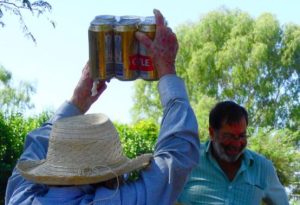
Meg celebrates
Christmas Party: We moved the Christmas Party away from the busy Christmas period so we no longer compete with other Clubs/Societies Xmas functions. Last year the combined AGM / Social was a great success. Besides the regular scavenger hunt and fun quiz, we added a bingo event to give away bottles of booze. We aim to have a lot more prizes for today’s bingo. Instead of having bingo cards with numbers, we just had a strip of five plant names.
Mary Lovemore, if my memory serves me right, was the first winner of a prize.
Lunch was a potjie and sides very kindly organized by Rob Jarvis and also thanks to Rob for organizing the scavenger hunt and the use of his property. He’s doing the same today! Thanks Rob.
How does everyone feel about having another social at some other time of the year? Same sort of format but perhaps with a braai with the Society paying for most of the costs.
Membership: As at the end of March 2023, we had 103 members, comprising 83 local members, 13 external and 7 honorary members. This is a decrease on last year’s numbers – down by 5. We probably now need to have a membership drive. However, we have had a few new members since the end of March.
Committee: We have not had any changes in the last year. The current committee now consists of the following seven people: Ann Sinclair, Bill Clarke, Teig Howson, Ryan Truscott, Rob Jarvis, Jan van Bel and myself. We are all available for re-election today.
Honorary Membership: Sometime back, the committee decided that anyone who has been a committee member for 10 years deserves to become an Honorary Member. Teig Howson now qualifies to be an Honorary Member – welcome to the small club! We have also agreed at committee level to Mary Toet becoming an Honorary Member as she has written many articles over many years for Tree Life.
In conclusion … We have had another very busy and interesting year!
Thank you.
Tony Alegria Photos Jim Dryburgh
Tree Society Committee and Contacts
Chairman Tony Alegria tonyalegria47@gmail.com 0772 438 697
Vice Chairman Rob Jarvis bo.hoom52@yahoo.com 0783 383 214
Honorary Treasurer Bill Clarke wrc@mweb.co.zw 0772 252 720
Projects Jan van Bel jan_vanbel@yahoo.com 0772 440 287
Venue Organiser Ann Sinclair jimandannsincs@zol.co.zw 0772 433 125
Tree of the Month Ryan Truscott ryan.kerr.truscott@gmail.com 0772 354 144
Secretary Teig Howson teig.howson@gmail.com 0772 256 364
Tree Society Website https://treesociety.org.zw/
Tree Society Facebook https://www.facebook.com/groups/ztreesociety/
Flora of Zimbabwe: https://www.zimbabweflora.co.zw/
Flora of Tropical Africa: https://plants.jstor.org/collection/FLOTA
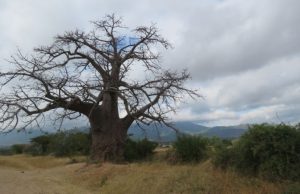
This baobab was photographed at the base of Buchwa Mountain in Mberengwa District, near Zivashavane. The mountain itself you can see in the background with a cap of dense cloud. For botanists it is an amazing mountain because it has its own eco-system, fed by the cold south easterlies that blow in from the Antarctic.
Stunning plantlife.


